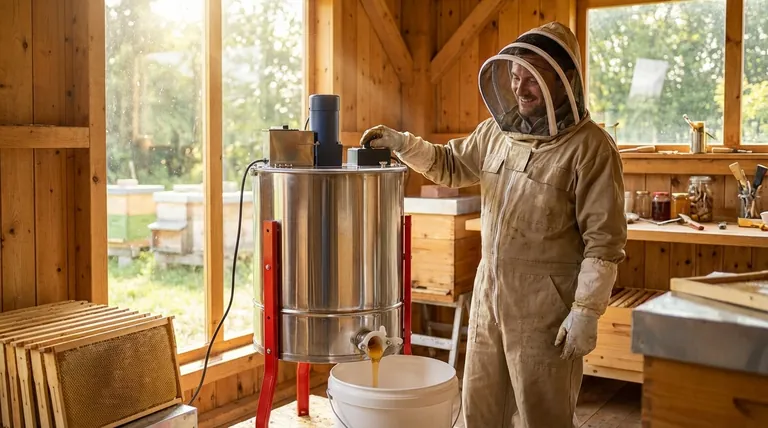At its core, a honey extractor is a tool that allows a beekeeper to harvest honey while keeping the delicate honeycomb intact. This single benefit creates a cascade of positive effects, leading to more efficient processing, higher quality honey, and healthier, less-stressed bee colonies. It transforms honey harvesting from a destructive process into a sustainable one.
A honey extractor isn't just about getting honey out of the frame faster. It's a strategic investment in the long-term health and productivity of your apiary by preserving the bees' most energy-intensive creation: their wax comb.

Why Preserving the Comb is a Game-Changer
The single most significant advantage of using a centrifugal honey extractor is the preservation of the drawn-out honeycomb. This has profound implications for the colony.
Reducing Bee Labor and Stress
Bees expend an enormous amount of energy and resources to produce wax and build their comb. It's estimated that bees consume about eight pounds of honey to produce just one pound of wax.
By preserving the comb, you give the bees a massive head start. They do not have to spend weeks rebuilding their entire pantry and nursery from scratch.
Accelerating Future Honey Production
When a beekeeper returns an empty, intact comb to the hive after extraction, the bees can immediately begin refilling it with new nectar.
This dramatically shortens the time it takes to produce the next batch of honey, leading to a much larger overall harvest within a single season.
Achieving Superior Efficiency and Quality
Beyond preserving the comb, extractors streamline the entire harvesting workflow, saving time and physical effort while yielding a better final product.
The Speed of Centrifugal Force
Honey extractors use centrifugal force to sling honey out of the comb's cells. This method is exceptionally fast compared to the alternative "crush and strain" method.
Electric extractors are particularly efficient, capable of processing many frames simultaneously with minimal user effort, making them ideal for larger-scale operations.
Cleaner, Higher-Quality Honey
Because the comb isn't crushed, far less wax debris, pollen, and other hive particles end up in the raw honey.
While the honey still requires straining, the initial product is much cleaner, simplifying the filtration process and resulting in a higher-quality final product.
Reducing Physical Strain
Harvesting honey can be a labor-intensive process. Automated or electric extractors alleviate the significant physical strain of manual methods.
This makes beekeeping more accessible and enjoyable, especially for those with physical limitations or during large harvests that would otherwise require hours of manual work.
Understanding the Trade-offs and Alternatives
While highly beneficial, an extractor is a significant investment and is not the only method for harvesting honey. Objectivity requires understanding its limitations.
The Initial Financial Investment
Honey extractors, particularly electric models, represent a notable upfront cost. This is the primary barrier for many new or small-scale beekeepers.
Manual vs. Electric Extractors
A manual extractor is powered by a hand crank. It is a more affordable option perfectly suited for hobbyists with only a few hives.
An electric extractor is faster and requires less labor, but is more expensive and needs a power source. It is the practical choice for any beekeeper managing more than a handful of colonies.
When Not to Use an Extractor
Extractors are designed for the strong, reinforced frames used in Langstroth or similar hive types.
They are generally unsuitable for Top Bar hives or hives that use foundationless frames. The delicate, naturally-drawn comb in these hives will be destroyed by the extractor's force. For these beekeepers, a honey press or the crush and strain method is the correct approach.
Choosing the Right Approach for Your Apiary
Your harvesting strategy should align directly with your beekeeping style, hive type, and long-term goals.
- If your primary focus is a hobby with 1-3 hives: A simple manual extractor is a great investment, but the traditional crush and strain method is also a perfectly viable starting point.
- If your primary focus is growing your operation (5+ hives): An electric extractor quickly becomes a non-negotiable tool for saving significant time and labor during harvest.
- If your primary focus is on Top Bar or foundationless beekeeping: A honey press is the appropriate tool for efficiently separating your honey and wax without relying on frames.
By matching your equipment to your apiary's specific needs, you ensure an efficient and sustainable harvest that supports the health of your bees.
Summary Table:
| Key Benefit | Impact on Your Apiary |
|---|---|
| Preserves Honeycomb | Saves bees weeks of labor, accelerating future honey production. |
| Boosts Efficiency | Centrifugal force extracts honey faster than manual methods. |
| Improves Honey Quality | Results in cleaner honey with less wax and debris. |
| Reduces Physical Strain | Electric models automate the process for large-scale operations. |
Ready to optimize your honey harvest?
As HONESTBEE, we supply commercial apiaries and beekeeping equipment distributors with the durable, high-performance extractors needed for efficient, large-scale operations. Our wholesale-focused solutions are designed to maximize your productivity and honey quality.
Contact our team today to discuss the best extractor for your commercial needs and request a wholesale quote.
Visual Guide

Related Products
- electric honey extractor honey centrifuge 3 frame honey extractor stainless steel honey frame extractor
- 8-Frame Electric Self-Reversing Honey Extractor Spinner for Commercial Honey Extraction Equipment
- Electric 8 Frame Honey Spinner Extractor Equipment for Beekeeping
- 40 Frame Commercial Electric Honey Extractor for Beekeeping
- 2 Frame Stainless Steel Manual Honey Spinner Extractor for Beekeeping
People Also Ask
- What is needed for honey extraction? A Complete Guide to Essential Tools & Methods
- What is a honey extractor and why is it beneficial for beekeepers? Boost Hive Health & Harvest Efficiency
- How does an electric honey extractor work? Automate Your Harvest for Maximum Efficiency
- What is the basic principle of the honey extractor? Harness Centrifugal Force for Efficient Harvesting
- How do automatic honey extractors function? Achieve High-Efficiency Honey Harvesting



















